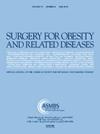解决Roux-en-Y胃旁路术后复发性体重增加:双重手术方法的有效性-单中心队列研究的短期结果
IF 3.8
3区 医学
Q1 SURGERY
引用次数: 0
摘要
背景:Roux-en-Y胃旁路手术(RYGB)后复发性体重增加没有金标准。联合1型远端空肠造口术(JJD1)和胃空肠造口及胃袋套筒切除术(GJ-P)可能是治疗这些患者的潜在方法。目的:描述JJD1套筒切除GJ-P患者的1年围手术期和营养状况。环境:高容量学术减肥中心。方法:纳入2020年至2022年期间接受JJD1 + GJ-P套筒切除术的RYGB术后复发性体重增加患者,术后1年进行研究。在手术过程中,我们的目标是总消化肢长度(TALL)为350-500 cm,新共通道(CC)为200-350 cm,并进行胃空肠吻合术。结果:共有61例患者接受了这种联合翻修手术。术前中位体重指数(BMI)为42.59 kg/m2。离体前后胆胰肢(BPL)中位长度分别为50 cm(四分位间距[IQR]: 42.5 ~ 75)和175 cm (IQR: 150 ~ 200)。修订后,中位新CC为270 cm (IQR: 250-300),中位TALL为400 cm(四分位数间距[IQR]: 362.5-450)。中位小肠总长度(TSBL)为580 cm (IQR为550 ~ 640 cm),中位BPL/TSBL比值为0.32 (IQR为0.29 ~ 0.34)。在第1、6和12个月时,该队列的中位BMI分别降至39.14、35.55和32.9 kg/m2。1年时,总体重减轻(%TWL)为22.18%。只有3例(n = 3)患者在1年内出现主要并发症。术后,所有与肥胖相关的合并症均得到改善,包括2型糖尿病(3.2%)、睡眠呼吸暂停(13.1%)、高血压(11.4%)和高脂血症(1.6%)。结论:JJD1联合GJ-P套筒切除术进行RYGB翻修是安全有效的,1年后体重减轻有明显改善。本文章由计算机程序翻译,如有差异,请以英文原文为准。
Addressing recurrent weight gain after Roux-en-Y gastric bypass: efficacy of a dual surgical approach—short-term results of a single-center cohort study
Background
There is no gold standard for recurrent weight gain following Roux-en-Y gastric bypass (RYGB). Combining jejuno-jejunostomy distalization type 1 (JJD1) and sleeve resection of the gastrojejunostomy and gastric pouch (GJ-P) may be a potential approach for these patients.
Objectives
To describe 1-year perioperative and nutritional outcomes of patients who underwent JJD1 with sleeve resection of the GJ-P.
Setting
High-volume academic bariatric center of excellence.
Methods
Patients with recurrent weight gain after RYGB who underwent JJD1 with sleeve resection of the GJ-P from 2020 to 2022 were included and studied for 1 year postoperatively. During the procedure, we aimed for a total alimentary limb length (TALL) of 350–500 cm, a new common channel (CC) of 200–350 cm, and a gastrojejunostomy <2 cm in diameter.
Results
A total of 61 patients underwent this combined revisional procedure. The median preoperative body mass index (BMI) was 42.59 kg/m2. The median lengths of the biliopancreatic limb (BPL) before and after distalizatiovn were 50 cm (interquartile range [IQR]: 42.5–75) and 175 cm (IQR: 150–200), respectively. After revision, the median new CC was 270 cm (IQR: 250–300) and the median TALL was 400 cm (interquartile range [IQR]: 362.5–450). The median total small bowel length (TSBL) was 580 cm (IQR 550–640 cm), and the median BPL/TSBL ratio was .32 (IQR .29–.34). At 1, 6, and 12 months, the median BMI of the cohort was reduced to 39.14, 35.55, and 32.9 kg/m2, respectively. At 1 year, the total weight loss (%TWL) was 22.18%. Only 3 (n = 3) patients developed major complications at 1 year. After distalization, the resolution of all obesity-related co-morbidities improved, including type 2 diabetes (3.2%), sleep apnea (13.1%), hypertension (HTN) (11.4%), and hyperlipidemia (HLD) (1.6%).
Conclusions
The combination of JJD1 and sleeve resection of the GJ-P for RYGB revision was safe and effective, with substantial improvement in weight loss at 1 year.
求助全文
通过发布文献求助,成功后即可免费获取论文全文。
去求助
来源期刊
CiteScore
6.70
自引率
12.90%
发文量
570
审稿时长
56 days
期刊介绍:
Surgery for Obesity and Related Diseases (SOARD), The Official Journal of the American Society for Metabolic and Bariatric Surgery (ASMBS) and the Brazilian Society for Bariatric Surgery, is an international journal devoted to the publication of peer-reviewed manuscripts of the highest quality with objective data regarding techniques for the treatment of severe obesity. Articles document the effects of surgically induced weight loss on obesity physiological, psychiatric and social co-morbidities.

 求助内容:
求助内容: 应助结果提醒方式:
应助结果提醒方式:


